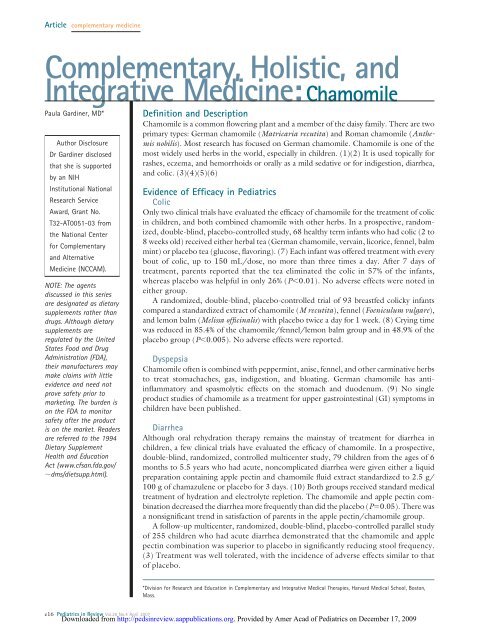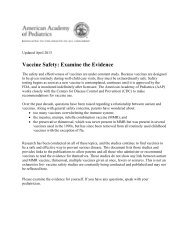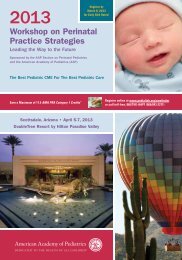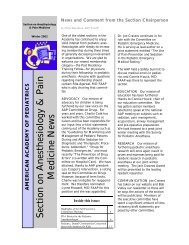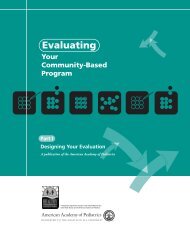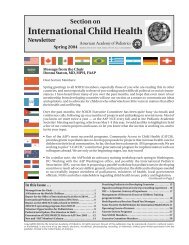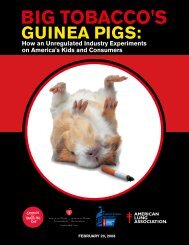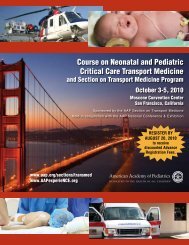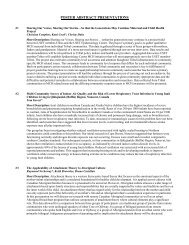Chamomile - American Academy of Pediatrics
Chamomile - American Academy of Pediatrics
Chamomile - American Academy of Pediatrics
You also want an ePaper? Increase the reach of your titles
YUMPU automatically turns print PDFs into web optimized ePapers that Google loves.
Article complementary medicine<br />
Complementary, Holistic, and<br />
Integrative Medicine: <strong>Chamomile</strong><br />
Paula Gardiner, MD*<br />
Author Disclosure<br />
Dr Gardiner disclosed<br />
that she is supported<br />
by an NIH<br />
Institutional National<br />
Research Service<br />
Award, Grant No.<br />
T32-AT0051-03 from<br />
the National Center<br />
for Complementary<br />
and Alternative<br />
Medicine (NCCAM).<br />
NOTE: The agents<br />
discussed in this series<br />
are designated as dietary<br />
supplements rather than<br />
drugs. Although dietary<br />
supplements are<br />
regulated by the United<br />
States Food and Drug<br />
Administration (FDA),<br />
their manufacturers may<br />
make claims with little<br />
evidence and need not<br />
prove safety prior to<br />
marketing. The burden is<br />
on the FDA to monitor<br />
safety after the product<br />
is on the market. Readers<br />
are referred to the 1994<br />
Dietary Supplement<br />
Health and Education<br />
Act (www.cfsan.fda.gov/<br />
dms/dietsupp.html).<br />
Definition and Description<br />
<strong>Chamomile</strong> is a common flowering plant and a member <strong>of</strong> the daisy family. There are two<br />
primary types: German chamomile (Matricaria recutita) and Roman chamomile (Anthemis<br />
nobilis). Most research has focused on German chamomile. <strong>Chamomile</strong> is one <strong>of</strong> the<br />
most widely used herbs in the world, especially in children. (1)(2) It is used topically for<br />
rashes, eczema, and hemorrhoids or orally as a mild sedative or for indigestion, diarrhea,<br />
and colic. (3)(4)(5)(6)<br />
Evidence <strong>of</strong> Efficacy in <strong>Pediatrics</strong><br />
Colic<br />
Only two clinical trials have evaluated the efficacy <strong>of</strong> chamomile for the treatment <strong>of</strong> colic<br />
in children, and both combined chamomile with other herbs. In a prospective, randomized,<br />
double-blind, placebo-controlled study, 68 healthy term infants who had colic (2 to<br />
8 weeks old) received either herbal tea (German chamomile, vervain, licorice, fennel, balm<br />
mint) or placebo tea (glucose, flavoring). (7) Each infant was <strong>of</strong>fered treatment with every<br />
bout <strong>of</strong> colic, up to 150 mL/dose, no more than three times a day. After 7 days <strong>of</strong><br />
treatment, parents reported that the tea eliminated the colic in 57% <strong>of</strong> the infants,<br />
whereas placebo was helpful in only 26% (P0.01). No adverse effects were noted in<br />
either group.<br />
A randomized, double-blind, placebo-controlled trial <strong>of</strong> 93 breastfed colicky infants<br />
compared a standardized extract <strong>of</strong> chamomile (M recutita), fennel (Foeniculum vulgare),<br />
and lemon balm (Melissa <strong>of</strong>ficinalis) with placebo twice a day for 1 week. (8) Crying time<br />
was reduced in 85.4% <strong>of</strong> the chamomile/fennel/lemon balm group and in 48.9% <strong>of</strong> the<br />
placebo group (P0.005). No adverse effects were reported.<br />
Dyspepsia<br />
<strong>Chamomile</strong> <strong>of</strong>ten is combined with peppermint, anise, fennel, and other carminative herbs<br />
to treat stomachaches, gas, indigestion, and bloating. German chamomile has antiinflammatory<br />
and spasmolytic effects on the stomach and duodenum. (9) No single<br />
product studies <strong>of</strong> chamomile as a treatment for upper gastrointestinal (GI) symptoms in<br />
children have been published.<br />
Diarrhea<br />
Although oral rehydration therapy remains the mainstay <strong>of</strong> treatment for diarrhea in<br />
children, a few clinical trials have evaluated the efficacy <strong>of</strong> chamomile. In a prospective,<br />
double-blind, randomized, controlled multicenter study, 79 children from the ages <strong>of</strong> 6<br />
months to 5.5 years who had acute, noncomplicated diarrhea were given either a liquid<br />
preparation containing apple pectin and chamomile fluid extract standardized to 2.5 g/<br />
100 g <strong>of</strong> chamazulene or placebo for 3 days. (10) Both groups received standard medical<br />
treatment <strong>of</strong> hydration and electrolyte repletion. The chamomile and apple pectin combination<br />
decreased the diarrhea more frequently than did the placebo (P0.05). There was<br />
a nonsignificant trend in satisfaction <strong>of</strong> parents in the apple pectin/chamomile group.<br />
A follow-up multicenter, randomized, double-blind, placebo-controlled parallel study<br />
<strong>of</strong> 255 children who had acute diarrhea demonstrated that the chamomile and apple<br />
pectin combination was superior to placebo in significantly reducing stool frequency.<br />
(3) Treatment was well tolerated, with the incidence <strong>of</strong> adverse effects similar to that<br />
<strong>of</strong> placebo.<br />
*Division for Research and Education in Complementary and Integrative Medical Therapies, Harvard Medical School, Boston,<br />
Mass.<br />
e16 <strong>Pediatrics</strong> in Review Vol.28 No.4 April 2007<br />
Downloaded from http://pedsinreview.aappublications.org. Provided by Amer Acad <strong>of</strong> <strong>Pediatrics</strong> on December 17, 2009
complementary medicine<br />
Dermatologic Conditions<br />
<strong>Chamomile</strong> has been used to treat conditions other than<br />
diaper rash. Clinical studies have consistently shown<br />
positive results in the treatment <strong>of</strong> atopic dermatitis,<br />
acute weeping skin disorders, decubitus ulcers, and<br />
radiation- and chemotherapy-induced oral mucositis.<br />
(11)(12)(13)(14)(15)(16) Most <strong>of</strong> the studies are small<br />
and <strong>of</strong> poor quality. Therefore, more research is needed<br />
to assess the efficacy <strong>of</strong> chamomile for the treatment <strong>of</strong><br />
skin conditions. Clinical trials and systematic reviews did<br />
not find that chamomile was effective in preventing acute<br />
radiation dermatitis. (17)(18)<br />
Safety<br />
Adverse Events<br />
A few case reports have documented atopic and contact<br />
dermatitis with the use <strong>of</strong> chamomile. (19)(20)(21)(22)<br />
Some individuals allergic to other members <strong>of</strong> the aster<br />
family (ragweed, asters, chrysanthemums) are allergic to<br />
chamomile. (19) There are case reports <strong>of</strong> chamomile<br />
eyewashes causing allergic conjunctivitis. There have<br />
been rare cases <strong>of</strong> anaphylaxis to chamomile.<br />
(4)(23)(24)(25)(26) No long-term problems have been<br />
identified from taking chamomile.<br />
Drug Interactions<br />
Three cases <strong>of</strong> chamomile interacting with cyclosporine<br />
in patients who have had renal transplants have been<br />
reported. (27) The mechanism is inhibition <strong>of</strong> the activity<br />
<strong>of</strong> P450 CYP1A2 and 3A4. (28)(29) Potential interactions<br />
with warfarin have been reported, theoretically<br />
through the same mechanism <strong>of</strong> inhibition <strong>of</strong> P450.<br />
(30)(31) There is a theoretical additive effect with other<br />
sedative and anxiolytic medications.<br />
Use in Pregnancy and Lactation<br />
No studies have reported the safety <strong>of</strong> using chamomile<br />
for women who are pregnant or breastfeeding, although<br />
chamomile is widely consumed during pregnancy as a<br />
beverage to treat morning sickness. (32)(33)<br />
Pharmacologic Action<br />
A total <strong>of</strong> 120 chemical constituents have been identified<br />
in chamomile, including terpenoids (chamazulene),<br />
flavonoids (apigenin and luteolin), and coumarins (umbelliferone,<br />
alpha-bisabolol). (34)(35) The flavonoids<br />
apigenin and luteolin possess anti-inflammatory, carminative,<br />
and antispasmodic properties. (34) The antiinflammatory,<br />
wound-healing, and antimicrobial effects<br />
<strong>of</strong> German chamomile are attributed to a blue essential<br />
oil that contains sesquiterpene alcohol, alpha-bisabolol,<br />
chamazulene, and flavonoids. (36)(37)(38)<br />
Administration/Dosage Forms<br />
Adult doses <strong>of</strong> chamomile usually are one cup <strong>of</strong> tea or<br />
1 to 4 mL <strong>of</strong> tincture (1:1 in 45% alcohol), three times<br />
daily by mouth. The pediatric dose <strong>of</strong> flower head is 2 g<br />
three times daily and for a single dose <strong>of</strong> fluid extract<br />
(ethanol 45% to 60%) is 0.6 mL to 2 mL. (39)<br />
Summary<br />
As part <strong>of</strong> any medication history, pediatricians always<br />
should ask a child’s caregiver about the child’s use <strong>of</strong><br />
over-the-counter remedies and herbal products. <strong>Chamomile</strong><br />
is used widely to treat children who have GI<br />
disorders such as colic, dyspepsia, and diarrhea and to<br />
treat skin conditions such as dermatitis. Clinical studies<br />
have demonstrated that chamomile may have a positive<br />
effect in the treatment <strong>of</strong> atopic dermatitis, colic, and<br />
diarrhea. There are few adverse effects in children. However,<br />
children who are allergic to ragweed, asters, and<br />
chrysanthemums should use chamomile with caution.<br />
References<br />
1. Lohse B, Stotts JL, Priebe JR. Survey <strong>of</strong> herbal use by Kansas and<br />
Wisconsin WIC participants reveals moderate, appropriate use and<br />
identifies herbal education needs. J Am Diet Assoc. 2006;106:<br />
227–237<br />
2. Noonan K, Arensman RM, Hoover JD. Herbal medication use<br />
in the pediatric surgical patient. J Pediatr Surg. 2004;39:500–503<br />
3. Becker B, Kuhn U, Hardewig-Budny B. Double-blind, randomized<br />
evaluation <strong>of</strong> clinical efficacy and tolerability <strong>of</strong> an apple<br />
pectin-chamomile extract in children with unspecific diarrhea.<br />
Arzneimittelforschung. 2006;56:387–393<br />
4. Blumental M. The ABC Clinical Guide to Herbs. Austin, Tex:<br />
The <strong>American</strong> Botanical Council; 2003<br />
5. Gardiner P. <strong>Chamomile</strong> (Matricaria recutita, Anthemis nobilis):<br />
Clinician Information Summary. Boston, Mass: The Longwood<br />
Herbal Task Force, The Center for Holistic Pediatric Education<br />
and Research; 2000. Available at: http://www.longwoodherbal.<br />
org/chamomile/chamomile.cis.pdf<br />
6. Blumenthal M, ed. The Complete German Commission E Monographs:<br />
Therapeutic Guide to Herbal Medicines. Austin, Tex: <strong>American</strong><br />
Botanical Council; 1998<br />
7. Weizman Z, Alkrinawi S, Goldfarb D, Bitran C. Efficacy <strong>of</strong><br />
herbal tea preparation in infantile colic. J Pediatr. 1993;122:<br />
650–652<br />
8. Savino F, Cresi F, Castagno E, Silvestro L, Oggero R. A randomized<br />
double-blind placebo-controlled trial <strong>of</strong> a standardized<br />
extract <strong>of</strong> Matricariae recutita, Foeniculum vulgare and Melissa<br />
<strong>of</strong>ficinalis (ColiMil) in the treatment <strong>of</strong> breastfed colicky infants.<br />
Phytother Res. 2005;19:335–340<br />
9. Mann C, Staba E. The chemistry, pharmacology, and commercial<br />
formuations <strong>of</strong> chamomile. Herbs, Spices and Medicinal Plants.<br />
1986;1:235–280<br />
<strong>Pediatrics</strong> in Review Vol.28 No.4 April 2007 e17<br />
Downloaded from http://pedsinreview.aappublications.org. Provided by Amer Acad <strong>of</strong> <strong>Pediatrics</strong> on December 17, 2009
complementary medicine<br />
10. De La Motte S, Bose-O’Reilly S, Heinisch M, Harrison F.<br />
Double-blind comparison <strong>of</strong> a preparation <strong>of</strong> pectin/chamomile<br />
extract and placebo in children with diarrhea. [German]. Arzneimittelforschung.<br />
1997;47:1247–1249<br />
11. Aertgeerts P, Albring M, Klaschka F, et al. Comparison <strong>of</strong><br />
Kamillosan cream (2 g ethanolic extract from chamomile flowers<br />
in 100 g cream) versus steroidal (0.25% hydrocortisone, 0.75%<br />
fluocortin butyl ester) and non-steroidal (5% bufexamac) dermatics<br />
in the maintenance therapy <strong>of</strong> eczema. Zeitschrift fur Hautkrankheiten.<br />
1985;60:270–277<br />
12. Fidler P, Loprinzi CL, O’Fallon JR, et al. Prospective evaluation<br />
<strong>of</strong> a chamomile mouthwash for prevention <strong>of</strong> 5-FU-induced<br />
oral mucositis. Cancer. 1996;77:522–525<br />
13. Schulz V, Hansel R, Tyler VE. Rational Phytotherapy: A Physicians’<br />
Guide to Herbal Medicine. 3rd ed. Berlin, Germany: Springer;<br />
1997<br />
14. Patzelt-Wenczler R, Ponce-Poschl E. Pro<strong>of</strong> <strong>of</strong> efficacy <strong>of</strong> Kamillosan<br />
® cream in atopic eczema. Eur J Med Res. 2000;5:171–175<br />
15. Glowania HJ, Raulin C, Swoboda M. The effect <strong>of</strong> chamomile<br />
on wound healing: a controlled clinical-experimental double-blind<br />
trial. Zeitschrift fur Hautkrankheiten. 1987;62:1262–1271<br />
16. Carl W, Emrich LS. Management <strong>of</strong> oral mucositis during local<br />
radiation and systemic chemotherapy: a study <strong>of</strong> 98 patients. J<br />
Prosthet Dent. 1991;66:361–369<br />
17. Wickline MM. Prevention and treatment <strong>of</strong> acute radiation<br />
dermatitis: a literature review. Oncol Nurs Forum. 2004;31:<br />
237–247<br />
18. Maiche AG, Grohn P, Maki-Hokkonen H. Effect <strong>of</strong> chamomile<br />
cream and almond ointment on acute radiation skin reaction.<br />
Acta Oncol. 1991;30:395–396<br />
19. Paulsen E. Contact sensitization from Compositae-containing<br />
herbal remedies and cosmetics. Contact Derm. 2002;47:189–198<br />
20. Rycr<strong>of</strong>t RJ. Recurrent facial dermatitis from chamomile tea.<br />
Contact Derm. 2003;48:229<br />
21. Pereira F, Santos R, Pereira A. Contact dermatitis from chamomile<br />
tea. Contact Derm. 1997;36:307<br />
22. Rodriguez-Serna M, Sanchez-Motilla JM, Ramon R, Aliaga A.<br />
Allergic and systemic contact dermatitis from Matricaria chamomilla<br />
tea. Contact Derm. 1998;39:192–193<br />
23. Subiza J, Subiza JL, Hinojosa M, et al. Anaphylactic reaction<br />
after the ingestion <strong>of</strong> chamomile tea: a study <strong>of</strong> cross-reactivity with<br />
other composite pollens. J Allergy Clin Immunol. 1989;84:<br />
353–358<br />
24. Thien FC. <strong>Chamomile</strong> tea enema anaphylaxis. Med J Aust.<br />
2001;175:54<br />
25. Reider N, Sepp N, Fritsch P, Weinlich G, Jensen-Jarolim E.<br />
Anaphylaxis to camomile: clinical features and allergen crossreactivity.<br />
Clin Exp Allergy. 2000;30:1436–1443<br />
26. Hausen BM. A 6-year experience with compositae mix. Am J<br />
Contact Dermat. 1996;7:94–99<br />
27. Nowack R, Nowak B. Herbal teas interfere with cyclosporin<br />
levels in renal transplant patients. Nephrol Dial Transplant. 2005;<br />
20:2554–2556<br />
28. Maliakal PP, Wanwimolruk S. Effect <strong>of</strong> herbal teas on hepatic<br />
drug metabolizing enzymes in rats. J Pharm Pharmacol. 2001;53:<br />
1323–1329<br />
29. Budzinski JW, Foster BC, Vandenhoek S, Arnason JT. An in<br />
vitro evaluation <strong>of</strong> human cytochrome P450 3A4 inhibition by<br />
selected commercial herbal extracts and tinctures. Phytomedicine.<br />
2000;7:273–282<br />
30. Heck AM, DeWitt BA, Lukes AL. Potential interactions between<br />
alternative therapies and warfarin. Am J Health Syst Pharm.<br />
2000;57:1221–1227<br />
31. Segal R, Pilote L. Warfarin interaction with Matricaria chamomilla.<br />
CMAJ. 2006;174:1281–1282<br />
32. Forster DA, Denning A, Wills G, Bolger M, McCarthy E.<br />
Herbal medicine use during pregnancy in a group <strong>of</strong> Australian<br />
women. BMC Pregnancy Childbirth. 2006;6:21<br />
33. Nordeng H, Havnen GC. Use <strong>of</strong> herbal drugs in pregnancy: a<br />
survey among 400 Norwegian women. Pharmacoepidemiol Drug<br />
Saf. 2004;13:371–380<br />
34. Salamon I. <strong>Chamomile</strong>, a medicinal plant. The Herb, Spice, and<br />
Medicinal Plant Digest. 1992;10:1–4<br />
35. McKenna D. Botanical Medicines. The Desk Reference <strong>of</strong> Major<br />
Herbal Supplements. New York, NY: The Haworth Herbal Press;<br />
2002<br />
36. Soliman KM, Badeaa RI. Effect <strong>of</strong> oil extracted from some<br />
medicinal plants on different mycotoxigenic fungi. Food Chem<br />
Toxicol. 2002;40:1669–1675<br />
37. Liu ZH, Nakano H. Antibacterial activity <strong>of</strong> spice extracts<br />
against food-related bacteria. Journal <strong>of</strong> the Faculty <strong>of</strong> Applied<br />
Biological Science, Hiroshima University. 1996;35:181–190<br />
38. Aggag ME, Yousef RT. Study <strong>of</strong> antimicrobial activity <strong>of</strong><br />
chamomile oil. Planta Med. 1972;22:140–144<br />
39. Mahady GB, Fong HH, Farnsworth N. Flos chamomillae.<br />
WHO Monographs on Selected Medicinal Plants. Geneva, Switzerland:<br />
World Health Organization Publications; 1999<br />
e18 <strong>Pediatrics</strong> in Review Vol.28 No.4 April 2007<br />
Downloaded from http://pedsinreview.aappublications.org. Provided by Amer Acad <strong>of</strong> <strong>Pediatrics</strong> on December 17, 2009
Complementary, Holistic, and Integrative Medicine: <strong>Chamomile</strong><br />
Paula Gardiner<br />
Pediatr. Rev. 2007;28;e16-e18<br />
DOI: 10.1542/pir.28-4-e16<br />
Updated Information<br />
& Services<br />
Subspecialty Collections<br />
Permissions & Licensing<br />
Reprints<br />
including high-resolution figures, can be found at:<br />
http://pedsinreview.aappublications.org/cgi/content/full/28/4/e16<br />
This article, along with others on similar topics, appears in the<br />
following collection(s):<br />
Complementary, Holistic, and Integrative Medicine<br />
http://pedsinreview.aappublications.org/cgi/collection/compleme<br />
ntary_holistic_integrative Gastrointestinal Disorders<br />
http://pedsinreview.aappublications.org/cgi/collection/gastrointe<br />
stinal_disorders Skin Disorders<br />
http://pedsinreview.aappublications.org/cgi/collection/skin_disor<br />
ders<br />
Information about reproducing this article in parts (figures,<br />
tables) or in its entirety can be found online at:<br />
http://pedsinreview.aappublications.org/misc/Permissions.shtml<br />
Information about ordering reprints can be found online:<br />
http://pedsinreview.aappublications.org/misc/reprints.shtml<br />
Downloaded from http://pedsinreview.aappublications.org. Provided by Amer Acad <strong>of</strong> <strong>Pediatrics</strong> on December 17, 2009


